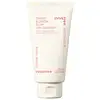What's inside
What's inside
 Key Ingredients
Key Ingredients

No key ingredients
 Benefits
Benefits

 Concerns
Concerns

 Ingredients Side-by-side
Ingredients Side-by-side

Water
Skin ConditioningGlycerin
HumectantPropanediol
SolventCoco-Glucoside
CleansingXanthan Gum
EmulsifyingSodium Cocoamphoacetate
CleansingCitric Acid
BufferingSodium Chloride
MaskingDisodium EDTA
Ethylhexylglycerin
Skin ConditioningCnidium Officinale Root Water
MaskingAngelica Acutiloba Root Water
Skin ConditioningButylene Glycol
HumectantDioscorea Japonica Root Extract
Skin ConditioningRubus Idaeus Fruit Extract
AstringentUlmus Davidiana Root Extract
Skin ConditioningSalicornia Herbacea Extract
Skin ConditioningMorus Alba Leaf Extract
Skin ConditioningAngelica Keiskei Extract
Antioxidant1,2-Hexanediol
Skin ConditioningTocopherol
AntioxidantWater, Glycerin, Propanediol, Coco-Glucoside, Xanthan Gum, Sodium Cocoamphoacetate, Citric Acid, Sodium Chloride, Disodium EDTA, Ethylhexylglycerin, Cnidium Officinale Root Water, Angelica Acutiloba Root Water, Butylene Glycol, Dioscorea Japonica Root Extract, Rubus Idaeus Fruit Extract, Ulmus Davidiana Root Extract, Salicornia Herbacea Extract, Morus Alba Leaf Extract, Angelica Keiskei Extract, 1,2-Hexanediol, Tocopherol
Water
Skin ConditioningGlycerin
HumectantSodium Cocoyl Alaninate
Disodium Cocoamphodiacetate
CleansingLauryl Hydroxysultaine
CleansingQuillaja Saponaria Bark Extract
CleansingPrunus Yedoensis Leaf Extract
Skin ConditioningBetaine
Humectant1,2-Hexanediol
Skin ConditioningAcrylates/C10-30 Alkyl Acrylate Crosspolymer
Emulsion StabilisingCaprylyl Glycol
EmollientSodium Chloride
MaskingCoco-Glucoside
CleansingSodium Cocoyl Isethionate
CleansingSodium Phytate
Propanediol
SolventHexylene Glycol
EmulsifyingCyanocobalamin
Skin ConditioningXanthan Gum
EmulsifyingParfum
MaskingWater, Glycerin, Sodium Cocoyl Alaninate, Disodium Cocoamphodiacetate, Lauryl Hydroxysultaine, Quillaja Saponaria Bark Extract, Prunus Yedoensis Leaf Extract, Betaine, 1,2-Hexanediol, Acrylates/C10-30 Alkyl Acrylate Crosspolymer, Caprylyl Glycol, Sodium Chloride, Coco-Glucoside, Sodium Cocoyl Isethionate, Sodium Phytate, Propanediol, Hexylene Glycol, Cyanocobalamin, Xanthan Gum, Parfum
 Reviews
Reviews

Ingredients Explained
These ingredients are found in both products.
Ingredients higher up in an ingredient list are typically present in a larger amount.
1,2-Hexanediol is a synthetic liquid and another multi-functional powerhouse.
It is a:
- Humectant, drawing moisture into the skin
- Emollient, helping to soften skin
- Solvent, dispersing and stabilizing formulas
- Preservative booster, enhancing the antimicrobial activity of other preservatives
Coco-Glucoside is a surfactant, or a cleansing ingredient. It is made from glucose and coconut oil.
Surfactants help gather dirt, oil, and other pollutants from your skin to be rinsed away.
This ingredient is considered gentle and non-comedogenic. However, it may still be irritating for some.
Learn more about Coco-GlucosideGlycerin is already naturally found in your skin. It helps moisturize and protect your skin.
A study from 2016 found glycerin to be more effective as a humectant than AHAs and hyaluronic acid.
As a humectant, it helps the skin stay hydrated by pulling moisture to your skin. The low molecular weight of glycerin allows it to pull moisture into the deeper layers of your skin.
Hydrated skin improves your skin barrier; Your skin barrier helps protect against irritants and bacteria.
Glycerin has also been found to have antimicrobial and antiviral properties. Due to these properties, glycerin is often used in wound and burn treatments.
In cosmetics, glycerin is usually derived from plants such as soybean or palm. However, it can also be sourced from animals, such as tallow or animal fat.
This ingredient is organic, colorless, odorless, and non-toxic.
Glycerin is the name for this ingredient in American English. British English uses Glycerol/Glycerine.
Learn more about GlycerinPropanediol is an all-star ingredient. It softens, hydrates, and smooths the skin.
It’s often used to:
Propanediol is not likely to cause sensitivity and considered safe to use. It is derived from corn or petroleum with a clear color and no scent.
Learn more about PropanediolChances are, you eat sodium chloride every day. Sodium Chloride is also known as table salt.
This ingredient has many purposes in skincare: thickener, emulsifier, and exfoliator.
You'll most likely find this ingredient in cleansers where it is used to create a gel-like texture. As an emulsifier, it also prevents ingredients from separating.
There is much debate on whether this ingredient is comedogenic. The short answer - comedogenic ratings don't tell the whole story. Learn more about comegodenic ratings here.
The concensus about this ingredient causing acne seems to be divided. Research is needed to understand if this ingredient does cause acne.
Scrubs may use salt as the primary exfoliating ingredient.
Learn more about Sodium ChlorideWater. It's the most common cosmetic ingredient of all. You'll usually see it at the top of ingredient lists, meaning that it makes up the largest part of the product.
So why is it so popular? Water most often acts as a solvent - this means that it helps dissolve other ingredients into the formulation.
You'll also recognize water as that liquid we all need to stay alive. If you see this, drink a glass of water. Stay hydrated!
Learn more about WaterXanthan gum is used as a stabilizer and thickener within cosmetic products. It helps give products a sticky, thick feeling - preventing them from being too runny.
On the technical side of things, xanthan gum is a polysaccharide - a combination consisting of multiple sugar molecules bonded together.
Xanthan gum is a pretty common and great ingredient. It is a natural, non-toxic, non-irritating ingredient that is also commonly used in food products.
Learn more about Xanthan Gum